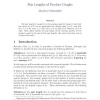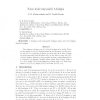17 search results - page 2 / 4 » A note on disjoint arborescences |
DM
2006
13 years 7 months ago
2006
The pair length of a graph G is the maximum positive integer k, such that the vertex set of G can be partitioned into disjoint pairs {x, x }, such that d(x, x ) k for every x V (...
DCC
2004
IEEE
14 years 7 months ago
2004
IEEE
The existence of large sets of 5-(14,6,3) designs is in doubt. There are five simple 5-(14,6,6) designs known in the literature. In this note, by the use of a computer program, we...
ORDER
2010
13 years 6 months ago
2010
Let r(n) denote the largest integer such that every family C of n pairwise disjoint segments in the plane in general position has r(n) members whose order type can be represented ...
DCG
2010
13 years 5 months ago
2010
Abstract. The Topological Radon Theorem states that, for every continuous function from the boundary of a (d + 1)-dimensional simplex into Rn , there exist a pair of disjoint faces...
ICDE
2010
IEEE
14 years 2 months ago
2010
IEEE
— Extracting useful correlation from a dataset has been extensively studied. In this paper, we deal with the opposite, namely, a problem we call correlation hiding (CH), which is...


